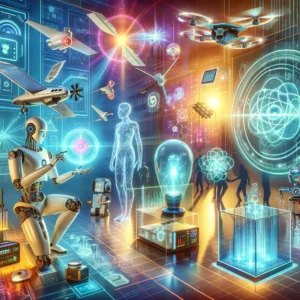
5G Vs. 6G: What’s Next for Mobile Networks?
5G Vs. 6G: What’s Next for Mobile Networks?
The rapid evolution of mobile networks has changed how we communicate, interact, and live. While 5G networks are still in their expansion phase, the tech world is already anticipating the next big leap: 6G. With promises of unprecedented speed, low latency, and applications we can barely imagine today, 6G is set to redefine our relationship with technology. But how does it differ from 5G, and what new advancements can we expect?
This article explores the differences between 5G and 6G, highlights the unique features of each, and discusses how 6G could transform mobile networks and impact our daily lives.
READ ALSO: How AI Is Revolutionizing the Future of Remote Work
5G: The Current Standard
Overview of 5G Technology
5G, or the fifth generation of mobile networks, represents a significant upgrade from 4G LTE. Launched in 2019, 5G was developed to support more connected devices, faster data speeds, and lower latency. Its primary goal is to enable the Internet of Things (IoT) and facilitate smoother connectivity in smart cities, autonomous vehicles, and industrial automation.
Key Features of 5G
Higher Data Speeds: 5G provides speeds up to 100 times faster than 4G, making it possible to download a full HD movie in seconds.
Low Latency: With latency as low as 1 millisecond, 5G enables real-time communication essential for applications like remote surgery and autonomous driving.
Enhanced Capacity: 5G can support a large number of devices simultaneously, essential for IoT ecosystems.
Network Slicing: This feature allows network operators to create multiple virtual networks within a single 5G infrastructure, enabling tailored services for different industries.

Current Applications of 5G
Enhanced Mobile Broadband: Faster and more reliable streaming, gaming, and virtual reality (VR) experiences.
Massive IoT Connectivity: Facilitates smart city developments, allowing devices to communicate seamlessly.
Critical Communications: Supports autonomous vehicles, remote healthcare, and emergency services by providing stable and low-latency connections.
While 5G is still in the rollout phase, its transformative effects are already visible. However, as we explore the potential of 6G, the limitations of 5G become more apparent.
—
6G: The Future of Connectivity
What is 6G?
6G, or the sixth generation of mobile networks, is still in its early research phase and is expected to launch around 2030. Building on 5G’s capabilities, 6G promises even faster speeds, lower latency, and broader coverage, including remote and rural areas. While the exact specifications of 6G are still evolving, experts predict it will go beyond traditional internet services to integrate with artificial intelligence (AI), machine learning (ML), and even quantum computing.
Key Features of 6G
Ultra-High Data Rates: Expected to deliver speeds up to 1000 times faster than 5G, 6G could facilitate applications like 3D holographic communication and real-time digital twins.
Terahertz Spectrum: Unlike 5G, which operates primarily on sub-6 GHz and millimeter waves, 6G is likely to use terahertz frequencies, allowing higher data transmission rates and bandwidth.
Integrated AI: 6G networks may leverage AI to optimize performance, predict network issues, and adapt to changing user demands autonomously.
Improved Coverage and Resilience: Enhanced satellite and aerial-based networks aim to provide global connectivity, reducing digital divides.
Extended IoT Capabilities: 6G’s massive capacity will enable sophisticated IoT ecosystems, supporting applications such as smart agriculture, remote construction, and intelligent healthcare.
Potential Applications of 6G
Holographic Communications: Imagine virtual meetings with 3D holograms instead of video calls.
Digital Twins: 6G could allow for real-time digital twins of physical spaces, assisting industries like manufacturing, healthcare, and urban planning.
Enhanced AR/VR Experiences: Higher data speeds and reduced latency could make augmented reality (AR) and virtual reality (VR) more immersive and accessible.
Quantum Computing Integration: 6G could support applications that require quantum-level processing, though this remains theoretical for now.
As 6G technology develops, we’ll likely see it applied in areas previously considered science fiction, enabling smart cities, advanced healthcare systems, and beyond.
—
Comparing 5G and 6G: What Sets Them Apart?
1. Data Speed
5G: Peak speeds up to 20 Gbps.
6G: Projected peak speeds up to 1 Tbps (terabits per second), 100 times faster than 5G.
2. Latency
5G: Latency as low as 1 ms.
6G: Expected latency under 1 ms, possibly down to microseconds, creating near-instantaneous data transfer.
3. Frequency Spectrum
5G: Utilizes sub-6 GHz and millimeter waves.
6G: Expected to use terahertz frequencies, which support higher data rates but may face propagation challenges.
4. Network Intelligence
5G: Incorporates basic network intelligence through cloud computing and virtualization.
6G: Plans to integrate AI and machine learning deeply, enabling smarter, self-optimizing networks.
5. Coverage and Connectivity
5G: Primarily ground-based, with limited satellite integration.
6G: Likely to integrate satellite and aerial networks for global coverage, including underserved rural areas.
—
Challenges and Potential Issues for 6G
Technical Limitations
One challenge for 6G is managing the terahertz spectrum, as higher frequencies tend to have shorter ranges and are more susceptible to interference. Researchers are exploring ways to optimize this frequency band to maintain consistent performance.
Energy Consumption
6G networks will require more energy to maintain high-speed, low-latency connections, leading to concerns about environmental impact. New technologies, such as energy-harvesting networks and efficient computing, are being researched to address this issue.
Privacy and Security
With the rise of AI and IoT in 6G networks, privacy and security will become critical. AI-driven networks will need robust security protocols to prevent unauthorized access and protect user data.
Infrastructure Costs
Deploying 6G networks will require significant infrastructure investment, especially for rural and remote areas. Governments and companies will need to collaborate on funding and regulatory support to overcome these financial barriers.
—
Final Thoughts: Is 6G Worth the Wait?
While 5G is still unfolding, the tech world is already gearing up for 6G, anticipating its transformative impact on various industries. From enabling futuristic applications like holographic communication to bridging connectivity gaps in remote areas, 6G has the potential to revolutionize our lives further than 5G. However, given the challenges in terms of cost, energy, and privacy, the road to 6G will require innovative solutions and collaboration across sectors.
For now, 5G continues to expand and unlock new possibilities in areas such as IoT, autonomous systems, and smart cities. As we approach the future, staying informed about these advancements will be crucial for consumers, businesses, and industries alike.





